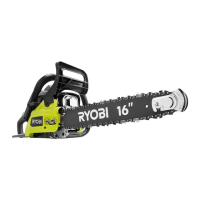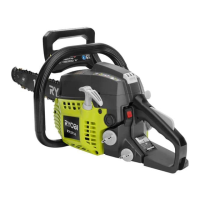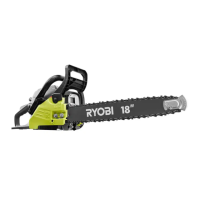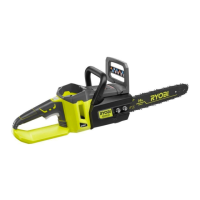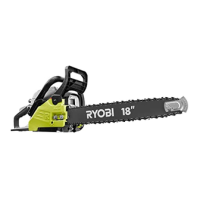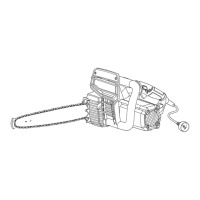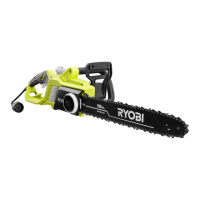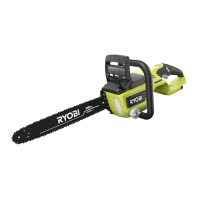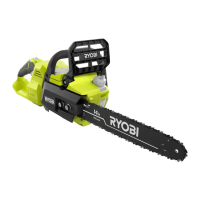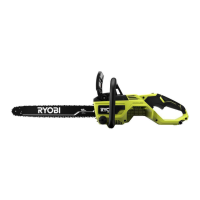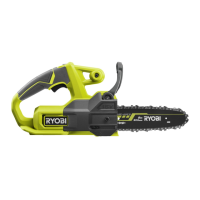OPERATOR’S MANUAL
MANUEL D’UTILISATION
MANUAL DEL OPERADOR
RY3714/RY3714VNM/
14 in. 38cc Chain Saw
Scie à chaîne de 38 cc de 35 cm (14 po)
Motosierra de 35 cm (14 pulg.), 38 cc
RY3716/ RY3716VNM/
16 in. 38cc Chain Saw
Scie à chaîne de 38 cc de 40 cm (16 po)
Motosierra de 40 cm (16 pulg.), 38 cc
ENGINE FAMILY: *HCPS.0384CA
FAMILLE DE MOTEUR : *HCPS.0384CA
FAMILIA DE MOTOR: *HCPS.0384CA
NOTICE AVIS AVISO
Do not use E15 or E85 fuel (or fuel containing greater than 10% ethanol) in this product. It is
a violation of federal law and will damage the unit and void your warranty.
Ne pas utiliser d’essence E15 ou E85 (ou un carburant contenant plus de 10 % d’éthanol) dans
ce produit. Une telle utilisation représente une violation de la loi fédérale et endommagera l’appareil et annulera la garantie.
No utilice combustibles E15 o E85 (ni combustibles que contengan más de 10 % de etanol) con este producto. Esto constituye
una violación a la ley federal, dañará la unidad y anulará la garantía.
WARNING: To reduce the
risk of injury, the user must read and
understand the operator’s manual
before using this product.
TABLE OF CONTENTS
General Safety Rules ...................... 2-3
Specific Safety Rules ...................... 3-4
Symbols .......................................... 5-6
Glossary of Terms ...............................7
Features .......................................... 8-9
Assembly ...................................... 9-10
Operation .................................... 10-24
Maintenance ............................... 24-37
Bar and Chain Combinations ............ 37
Troubleshooting .......................... 38-39
Parts Ordering/Service ........ Back Page
AVERTISSEMENT : Pour
réduire les risques de blessures,
l’utilisateur doit lire et veiller à bien
comprendre le manuel d’utilisation avant
d’employer ce produit.
TABLE DES MATIÈRES
Règles de sécurité générales .......... 2-3
Règles de sécurité particulières ...... 3-4
Symboles ........................................ 5-6
Glossaire .............................................7
Caractéristiques .............................. 8-9
Assemblage .................................. 9-10
Utilisation .................................... 10-24
Entretien ...................................... 24-38
Combinaisons de guide et chaîne ....38
Dépannage .................................. 39-40
Commande de pièces/
réparation .......................... Páge arrière
ADVERTENCIA: Para reducir
el riesgo de lesiones, el usuario debe leer
y comprender el manual del operador
antes de usar este producto.
ÍNDICE DE CONTENIDO
Reglas de seguridad generales ...... 2-3
Reglas de seguridad específicas .... 3-4
Símbolos ......................................... 5-6
Glosario de términos ........................... 7
Características ................................ 8-9
Armado ......................................... 9-10
Funcionamiento .......................... 10-24
Mantenimiento ............................ 24-38
Combinaciones de barra y cadena ...38
Corrección de problemas ........... 39-40
Pedidos de piezas/
servicio ........................... Pág. posterior
SAVE THIS MANUAL FOR
FUTURE REFERENCE
CONSERVER CE MANUEL
POUR FUTURE RÉFÉRENCE
GUARDE ESTE MANUAL
PARA FUTURAS CONSULTAS
